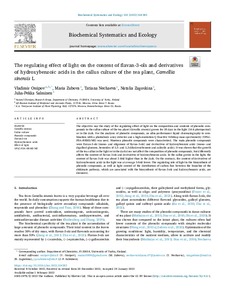The regulating effect of light on the content of flavan-3-ols and derivatives of hydroxybenzoic acids in the callus culture of the tea plant, Camellia sinensis L
Zagoskina Natalia; Salminen Juha-Pekka; Ossipov Vladimir; Zubova Maria; Nechaeva Tatiana
https://urn.fi/URN:NBN:fi-fe2022081154394
Tiivistelmä
The objective was the study of the regulating effect of light on the composition and contents of phenolic compounds in the callus culture of the tea plant (Camellia sinensis) grown for 28 days in the light (16-h photoperiod) or in the dark. For the analyses of phenolic compounds, an ultra-performance liquid chromatography in combination with a photodiode array detector and a high-resolution Q Exactive Orbitrap mass spectrometry (UPLC-PDA-HRMS/MS) was used. Nineteen phenolic compounds were characterized. The main phenolic compounds were flavan-3-ols (mono- and oligomers of flavan-3-ols) and derivatives of hydroxybenzoic acids (mono- and digalloyl glucoses, hexosides of 2,5- and 2,3-dihydroxybenzoic and salicylic acids). It was shown that the growth of the tea callus in the light or in the dark does not affect the composition of phenolic compounds, but differently affects the content of flavan-3-ols and derivatives of hydroxybenzoic acids. In the callus grown in the light, the content of flavan-3-ols was about 2-fold higher than in the dark. On the contrary, the content of derivatives of hydroxybenzoic acids in the light was at average 3-fold lower. The regulating role of light in the biosynthesis of phenolic compounds, as well as light control of the distribution of carbon flux between the branches of the shikimate pathway, which are associated with the biosynthesis of flavan-3-ols and hydroxybenzoic acids, are discussed.
Kokoelmat
- Rinnakkaistallenteet [19250]
